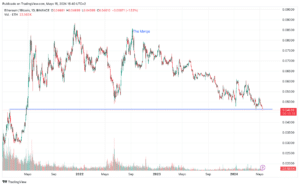The dream of Ethereum surpassing bitcoin’s market cap, a development known as “the Flippening,” seems more distant than ever. Ethereum’s value relative to bitcoin (ETH/BTC) is at its lowest point in years, having recently fallen to 0.046, its lowest point since February 2021.
Moreover, since Ethereum’s big transition to proof of stake in September 2022, aka “The Merge,” ETH/BTC has dropped by 45%.

Ethereum’s mainnet activity has also been quiet. Transaction fees, measured in gwei, are at a multi-year low due to more activity moving to Layer 2 networks on Ethereum, and showing that there’s not much happening on the network.
Read more: Why Ethereum Gas Fees Have Fallen to Their Lowest Level Since 2020
Experts Weigh In
Even Ryan Sean Adams, the co-host of the Bankless podcast who’s known for being a prominent supporter of Ethereum, is starting to have doubts. He recently wrote a post entitled “Will This Cycle Skip Ethereum?” discussing why some investors believe ETH might underperform in the current market cycle. The article outlines how Ethereum’s transition to Layer 2 solutions and its “awkward puberty phase” could lead to fragmentation and user frustration, potentially causing it to lag behind bitcoin and other cryptocurrencies during this bull run.
Joe McCann, founder, CEO, and CIO of crypto fund Asymmetric, believes the Flippening was always a dream. He says that while Ethereum has had significant VC funding and media attention, its bullish narratives are no longer strong. “Ethereum as an L1 is bound by the laws of physics and given its architectural design it simply cannot scale to meet the throughput and speed necessary to be a ‘super computer,” McCann argues. He further asserts that bitcoin remains “ultrasound money,” while Solana has become the “world’s leading supercomputer.”
Read more: Ethereum Scaling With L2s Has Damaged Its Tokenomics. Is It Possible to Fix It?
Some experts remain hopeful, however. Connor Loewen, analyst at Canadian investment firm 3iQ, points to regulatory and legal developments that could drive ETH/BTC higher. He notes that Ethereum is dominant in fiat-backed stablecoin issuance, with over $80 billion issued on its mainnet and scaling solutions. And positive legislation on stablecoins could have a significant impact on Ethereum’s valuation. “We see Ethereum as the best network suited to amplify the US dollar’s role within the broader crypto ecosystem in the near-term,” Loewen says.
Alex Kruger, founder of advisory firm Asgard, presents two scenarios for ETH: one where regulatory clarity and potential ETF approvals could drive prices higher, and another where a rejection might lead to a short-term dip before a rebound. Kruger believes the former scenario is more likely, suggesting that the market is poised for a potential turnaround.
Read more: Why Spot Ether ETFs Will Likely Have to Wait Until After the Presidential Election to Be Approved
Joe Di Pasquale, CEO of BitBull Capital, also sees a brighter future for Ethereum. He highlights Ethereum’s unique features, such as its proof of stake mechanism and smart contract capabilities, which make it an attractive platform for decentralized applications. Di Pasquale also notes historical trends where bitcoin initially rises faster after market crashes, but Ethereum and other altcoins catch up and often outperform in subsequent years.
Many Ethereum believers have fervently hoped for the Flippening, but with these recent trends, it seems that dream might be slipping away. However, differing opinions from industry experts suggest that Ethereum’s journey is far from over.
For now, bitcoin remains the king of the crypto world. Ethereum still has a lot to prove if it wants to take the crown.



